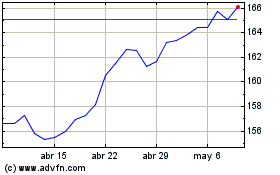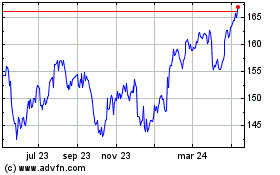Company's sales gains point to buoyant economy and some room to
raise prices
By Aisha Al-Muslim
This article is being republished as part of our daily
reproduction of WSJ.com articles that also appeared in the U.S.
print edition of The Wall Street Journal (January 24, 2019).
Procter & Gamble Co. reported strong quarterly sales,
continuing a streak of robust gains and prompting the
consumer-products giant to raise its outlook, while one of its
closest rivals posted weaker results.
Profit for the maker of Tide detergent and Pampers diapers rose
28% in the latest quarter, even as planned price increases were yet
to take full effect. "As commodity prices and foreign exchange
rates move, we will take pricing" higher, P&G finance chief Jon
Moeller said Wednesday during a call with analysts.
Kimberly-Clark Corp., whose products include Huggies diapers and
Kleenex tissues, said Wednesday its profit and sales dropped in
2018's final quarter because of rising commodity costs and currency
swings.
P&G joined several other major U.S. corporations this week
in reporting a bountiful finish to 2018. Many companies benefited
from a healthy U.S. economy and lower tax rates, which offset
concerns about trade tensions with China and, more recently, the
federal government shutdown.
Tech giant International Business Machines Corp. and industrial
conglomerate United Technologies Corp., which makes Otis elevators
and Pratt & Whitney jet engines, pointed to healthy spending by
their business customers. Shares of all three companies rallied
Wednesday on their latest results.
Executives at United Technologies said they had seen no impact
on their business from the U.S. government shutdown, and they
continue to forecast strong economic growth in the U.S. and
China.
"The U.S. again really, really pretty good outlook for this year
off the back of some strong orders that we saw in 2018," Chief
Executive Greg Hayes said during a conference call on
Wednesday.
For P&G, the gains came from household spending across a
number of categories, with beauty products leading the way. Organic
sales, a closely watched metric that strips out currency moves,
acquisitions and divestitures, rose 4% in its fiscal second
quarter, ended Dec. 31. Only its grooming business, which includes
the Gillette brand, posted a decline in organic sales in the
period.
The Gillette shaving brand has faced competition from upstarts
and has resorted to lowering prices to maintain its leading market
share. Last week, Gillette released -- to mixed consumer reactions
-- a campaign invoking the #MeToo movement.
In the conference call with reporters, Mr. Moeller said some
people go as long as a year without buying shaving products, making
for what he described as a "long-purchase-cycle business." He also
said the Gillette brand continues to add to its users and
sales.
Despite a robust U.S. economy and strong consumer spending,
household-goods stalwarts like P&G and Kimberly-Clark have
battled increased competition, a consumer shift toward smaller
brands, and higher costs of raw materials and transportation.
After addressing weak demand by lowering prices, P&G changed
course late last year, saying it would increase prices in late 2018
and early 2019 for several products, including its Pampers, Bounty,
Charmin and Puffs brands. Kimberly-Clark and other consumer-goods
makers have followed P&G's lead on raising prices.
Higher prices contributed a percentage point to P&G's
organic sales growth of 4% in the recent quarter.
So far, price increases on various products have been announced
but not fully implemented, Mr. Moeller said Wednesday, adding that
most of the increases will take effect in the current and next
quarter. He warned analysts that higher pricing "will increase
volume uncertainty and volatility."
The organic growth in P&G's fiscal second quarter matched
the first quarter, which was the best growth rate in several years.
For a long stretch, P&G generally logged growth of no more than
2% -- a performance that led to a proxy fight from activist
investor Trian Fund Management, whose co-founder Nelson Peltz now
holds a seat on the P&G board.
P&G on Wednesday said its profit rose to $3.19 billion in
the latest period. Net sales were flat at $17.44 billion, as
unfavorable foreign-exchange fluctuations cut into the total.
P&G said it expects organic sales growth for the full year of
between 2% and 4%, an improvement on its prior projection of 2% to
3%.
Kimberly-Clark posted quarterly earnings of $411 million, down
33% from a year earlier. Total sales fell 1% to $4.57 billion, hurt
by currency swings. Its organic sales rose 3%.
For 2019, Kimberly-Clark predicted organic sales would increase
2%. However, given planned price increases and fewer promotions,
volumes are likely to suffer, particularly with consumer tissue
products, executives said during a conference call.
In October, Kimberly-Clark said it was switching chief
executives in the midst of a restructuring program intended to
boost profits as the company struggled with weak sales. Michael
Hsu, the former president and chief operating officer who became
chief executive earlier this month, said Wednesday the company
expects 2019 to be challenging but "somewhat better than in
2018."
--Thomas Gryta contributed to this article.
Write to Aisha Al-Muslim at aisha.al-muslim@wsj.com
(END) Dow Jones Newswires
January 24, 2019 02:47 ET (07:47 GMT)
Copyright (c) 2019 Dow Jones & Company, Inc.
Procter and Gamble (NYSE:PG)
Gráfica de Acción Histórica
De Mar 2024 a Abr 2024

Procter and Gamble (NYSE:PG)
Gráfica de Acción Histórica
De Abr 2023 a Abr 2024
